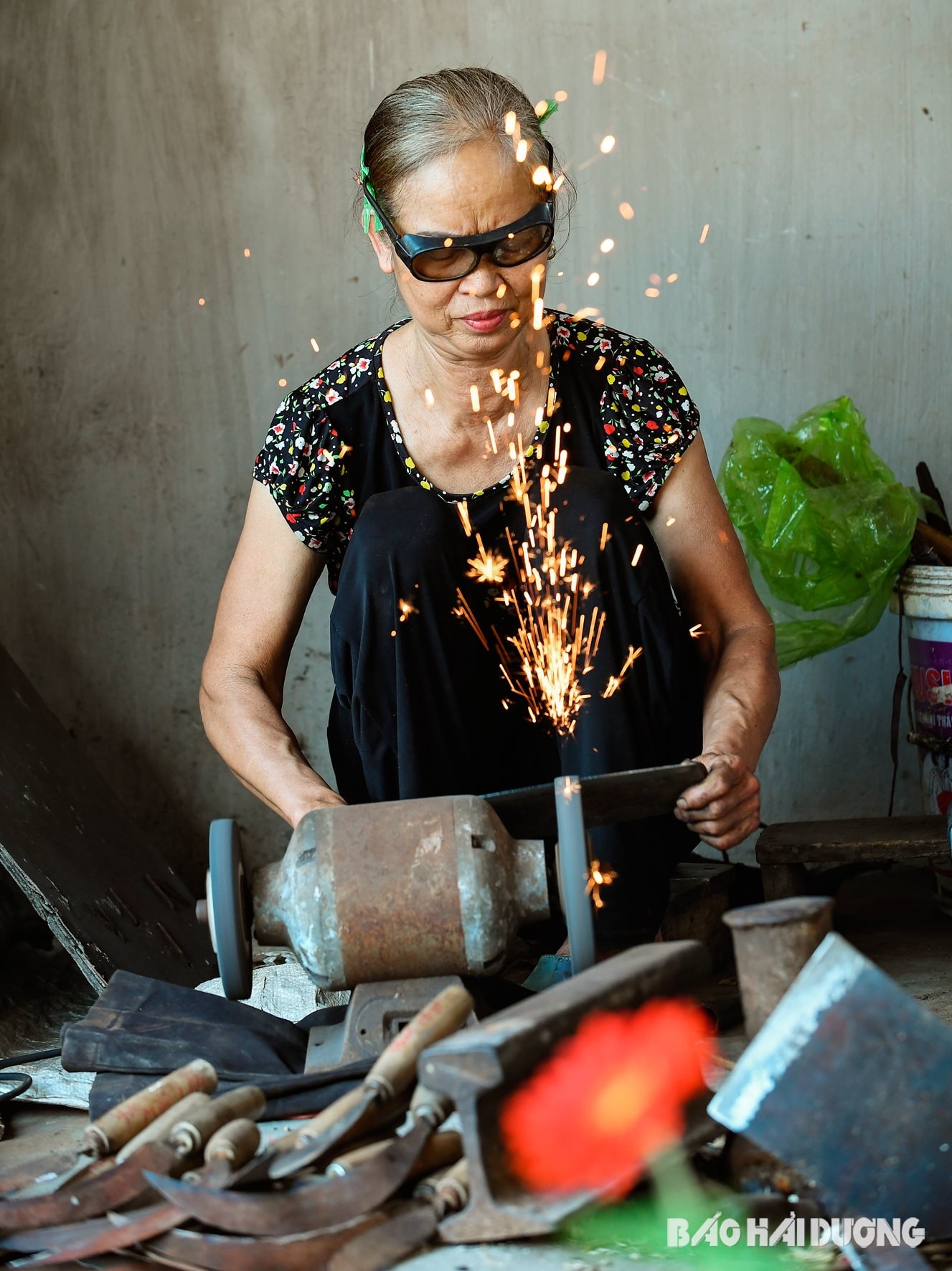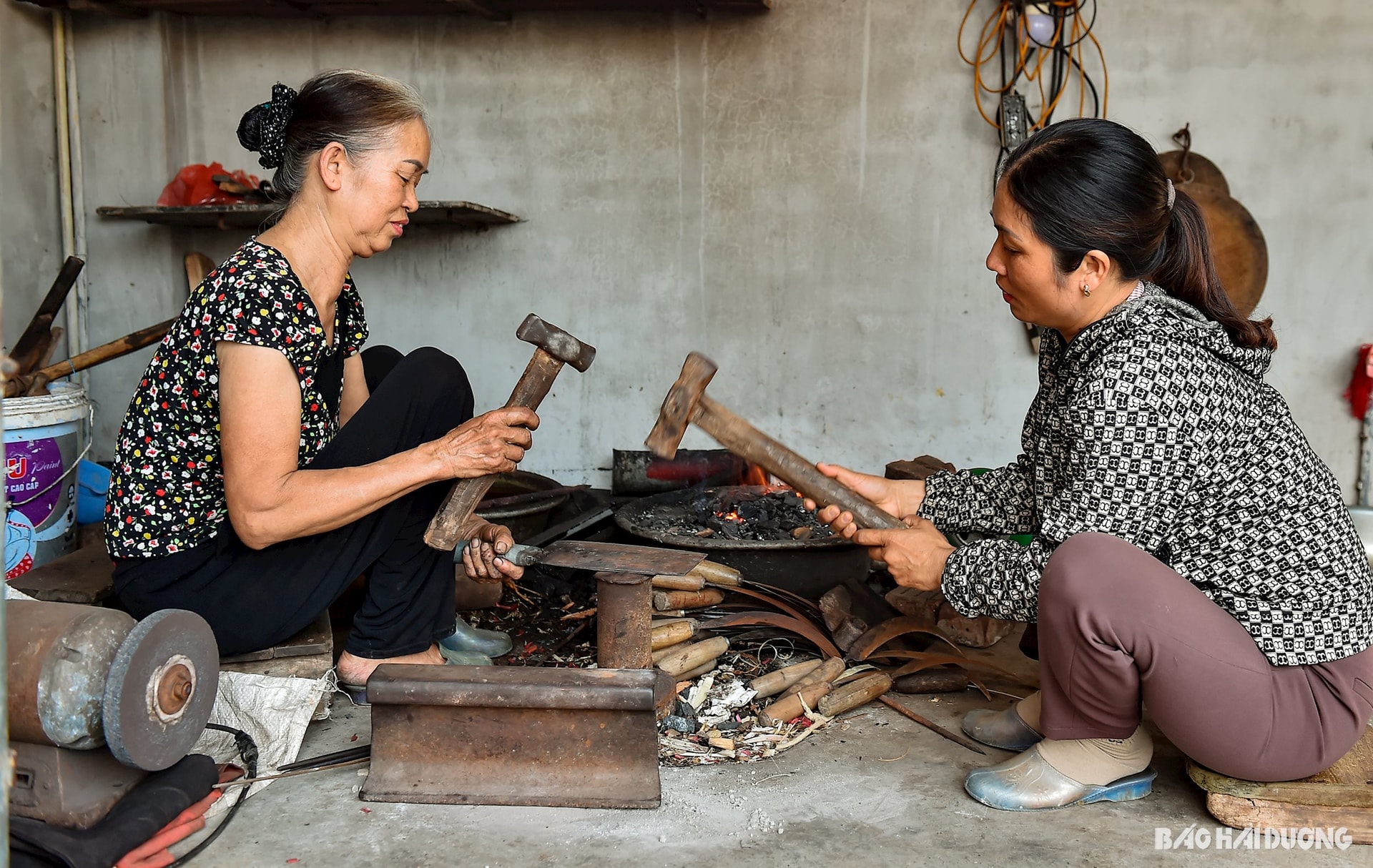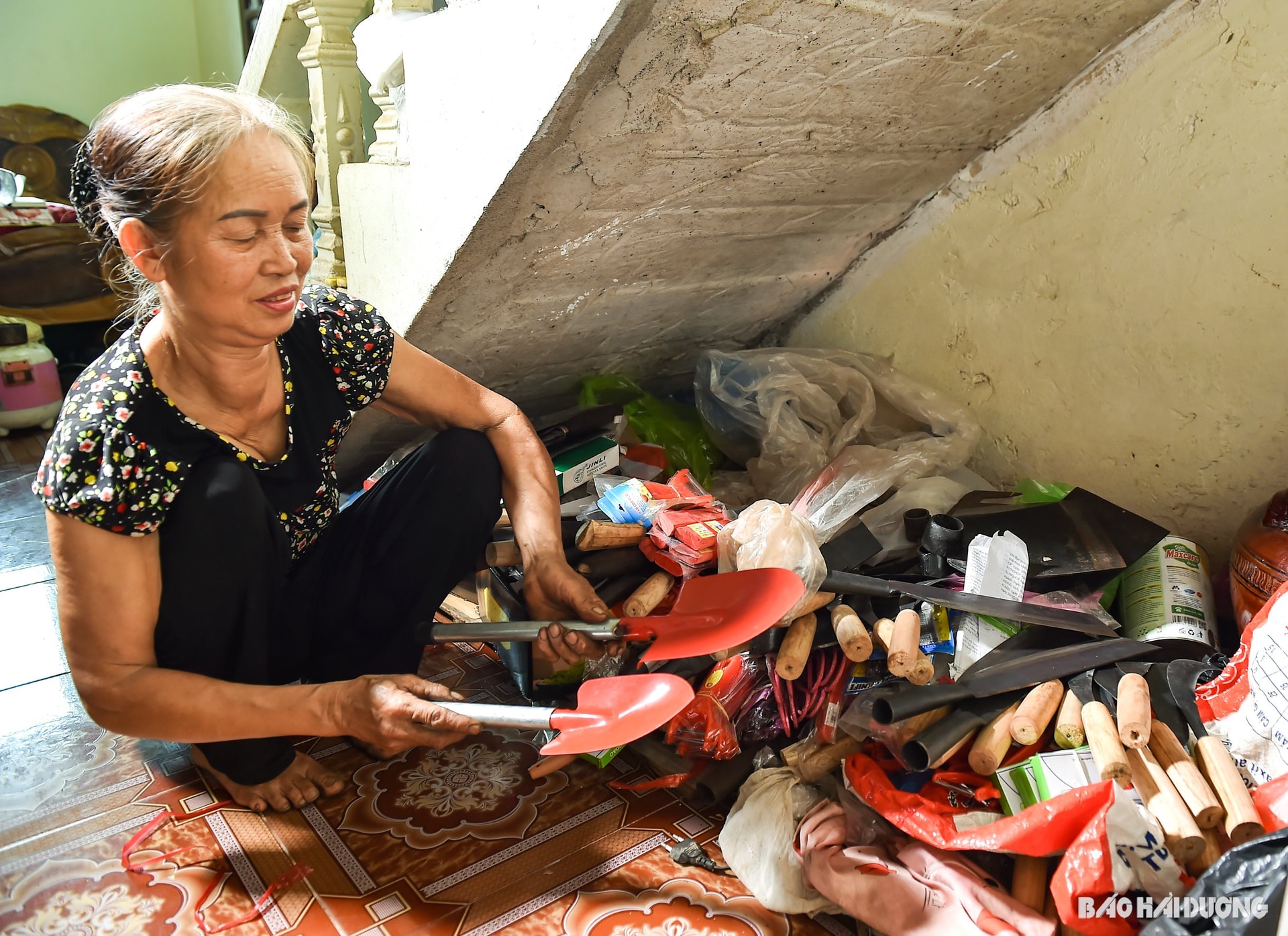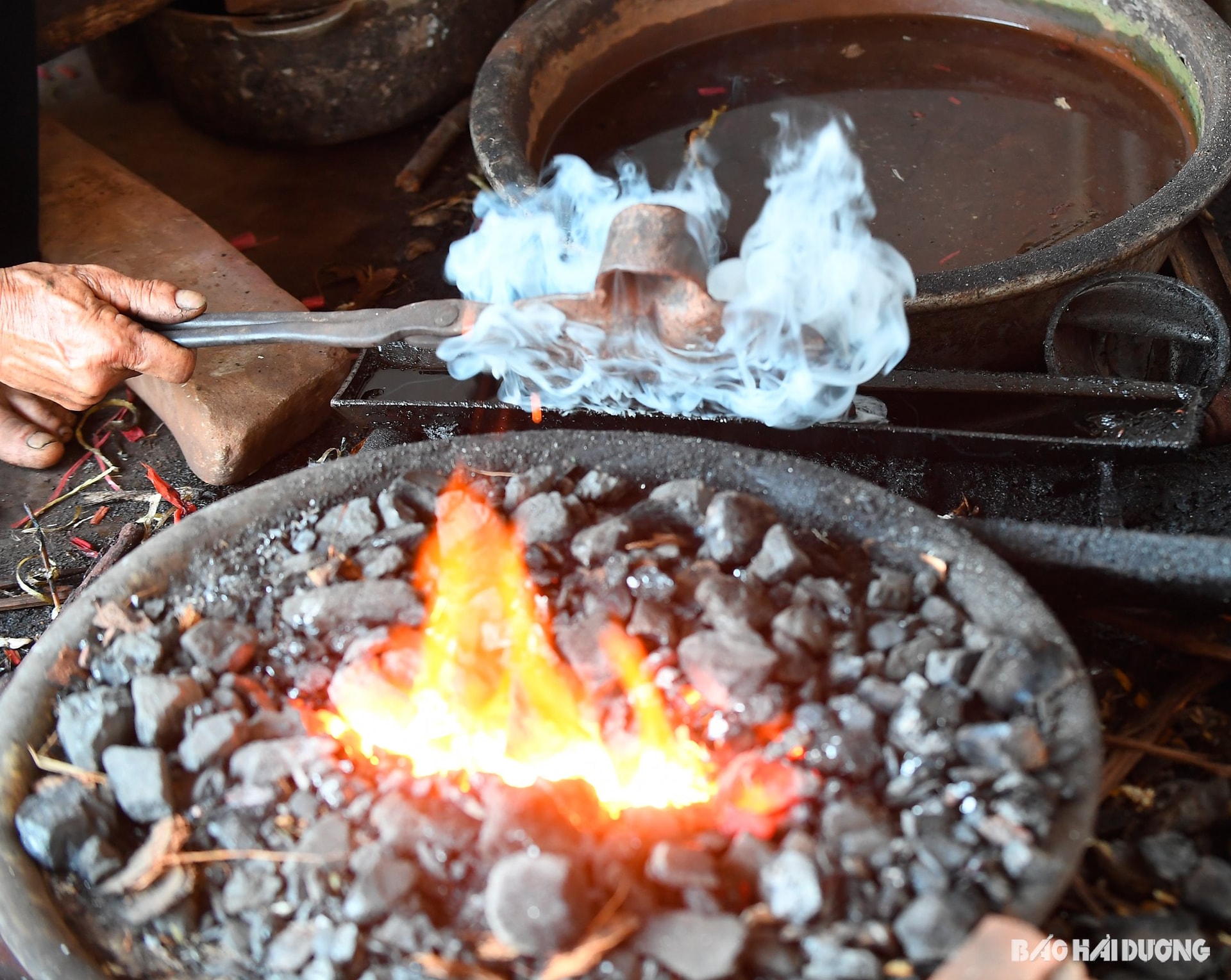The golden age has passed, but many women in the blacksmithing village of Kiem Tan, Quang Nghiep commune (Tu Ky, Hai Duong) are still involved in the 'hammer-handling' profession. They keep the profession because in addition to making a living, it is also a legacy left by their ancestors.

Childhood with hammer and anvil
One early winter afternoon, approaching the forge of Mrs. Nguyen Thi Xuan's family (66 years old) in Kiem Tan craft village, we heard the continuous sound of hammers and the hissing of grinding machines.
In a space of about 20m2, Mrs. Xuan and her daughter, Ms. Nguyen Thi Tham (40 years old) are skillfully hammering on the red-hot steel bar. Very rhythmically, one hammer layer after another, "fireworks" shoot out all around until the steel piece takes shape...
While wiping sweat from her hands, Mrs. Xuan told us about the hardships of being a blacksmith.
Growing up in a blacksmith family, Ms. Xuan's childhood was associated with hammers, anvils and the fire of the forge. Ms. Xuan's father was Mr. Tu - one of the most famous people in the Kiem Tan craft village, revered by the locals as the "ancestor of the profession".
After school, Mrs. Xuan often stayed home to help her father with his work. With her intelligence and quickness, at the age of 15, Xuan was able to do most of the steps of the blacksmithing profession, from lighting the stove to hammering, welding, sawing, grinding, etc. The first product she made by herself was a sickle. Although the design was not beautiful, it was an unforgettable memory.

When she grew up, she followed the profession and has been attached to it until now. Every day, Mrs. Xuan still works hard by the furnace to create sophisticated handmade products, becoming a veteran "hammer" in the village.
According to Ms. Xuan, the blacksmith profession requires workers to be healthy, skillful, as well as persistent and creative.
Over 40 years in the profession, Ms. Xuan has had many happy and sad memories, even had accidents such as burns and cuts on her hands, but her love for the profession is still burning.
While telling the story, Mrs. Xuan recited a verse from the poem "Forge" by author Khanh Nguyen: "Among hundreds of professions, choose the blacksmith profession/ Sit down and wipe your back and nose with soot/ Spend eight hours with coal feet and dusty face….Although her hands were dirty and calloused, Mrs. Xuan's hammer was still powerful.
According to Ms. Xuan, any profession requires the worker to have a heart, and blacksmithing is no exception. The worker must always keep his word, making products that are durable, beautiful, and convenient. Because she values the profession that has supported her family, she wants to keep it and pass it on to her children and grandchildren. "As long as I am healthy, I will continue to forge. Only when I feel I can no longer do it will I stop," Ms. Xuan shared.
Ms. Nguyen Thi Lai (64 years old) is Ms. Xuan's younger sister, also from Kiem Tan village and is still attached to the blacksmithing profession. Ms. Lai believes that blacksmithing is also forging people, so every craftsman is devoted to the product, because it is the reputation and brand of the family and themselves. Craftsmen of Kiem Tan village also carve unique symbols to mark their brand. On each product of Kiem Tan village is engraved the number 22. This is a number that the "ancestors" in the village set themselves because they believe that the number has a profound meaning, representing power and strength.
Keep the passion for the profession

The work is hard and seems to be only suitable for men, but the special thing about the Kiem Tan blacksmithing village is that the majority of the “hammers” are women. Currently, the number of women working in the blacksmithing profession accounts for more than half of the remaining workers here.
Following the previous generations, the women of the Kiem Tan blacksmithing profession advise each other to take care of each product, to preserve the reputation, the profession, and the ancestors' legacy... While telling stories about the village and themselves, they are still passionate and proud, but also filled with concerns for a sustainable direction for the profession.
The sound of hammering all month, all year round has entered the subconscious of Mrs. Xuan, Mrs. Lai and many elderly people in Kiem Tan blacksmith village. In the golden age, people lived with the sound of hammering, earned money from the sound of hammering. The image of the husband hammering, the wife sharpening the knife became a beautiful, familiar image of the craft village.
Not only loving their profession, women in Kiem Tan blacksmith village also accumulate experience to improve techniques and diversify products to suit market needs.
The blacksmiths were often on fire all year round but still could not keep up with the orders. There were many days when they could not finish all the work, so the blacksmiths had to work at night to deliver the orders on time. Many families became well-off, with food and savings thanks to this profession.
In the past, the villagers mainly worked by hand. Now machines have begun to be used to reduce labor. However, that does not mean that all stages are replaced by machines, because the "soul" of the product still depends on the technique of the long-time blacksmith.
The good reputation spreads far and wide. Today, the products of Kiem Tan craft village are still made to order and transported to all provinces and cities in the country, bringing a stable income of 6-10 million VND/month for those working in the profession.
Thanks to meticulousness and attention to detail in each product, the Kiem Tan forging brand still stands firm in the market thanks to its sharpness, sophistication, durability and beauty.

Time flies, there are not many experienced hammerers like Mrs. Xuan left. Age and competition from mass-produced industrial products have caused many people to put down their hammers and extinguish the fire in their forges. Very few young people today choose blacksmithing as a career to stick with and build a long-term career. The youngest who still keeps the “fire of the profession” is around 40 years old.
Even the descendants of the blacksmith village, who know a little about the craft, also choose other, easier jobs to make a living. The blacksmithing profession was once popular and developed in society, but now, due to industrial development, it is difficult for craftsmen to maintain their profession.
“If women don’t really love the job, no one will want to pursue blacksmithing because it’s hard work. All day long, we’re drenched in sweat because of the heat and coal dust. Therefore, my children all chose other jobs and only help their mother when there are many orders,” said Nguyen Thi Lai.
According to Party Cell Secretary and Head of Kiem Tan Village Pham Quang Oai, the Kiem Tan carpentry craft (also known as Gom Village) was recognized as a craft village in 2015. Currently, the craft village has only 4 families "keeping the fire" of the craft alive.
"The villagers and the village government hope that the Party Committee and local government will pay more attention to preserving and promoting the traditional craft of their homeland. Focus on vocational orientation and training for the younger generation, and at the same time have appropriate mechanisms to support households doing the craft. Only then can we retain young human resources and avoid the risk of losing traditional crafts," Mr. Oai said.
Vice Chairman of Tu Ky District People's Committee Duong Ha Hai said that to increase income for craft village workers, the district's localities have actively supported in finding markets for their products. The district has selected a number of craft villages to include in the local tourism development project.
Currently, some products of the craft villages are put on e-commerce platforms, helping people consume the products and promoting the traditional craft villages of the locality. The blacksmithing profession in Kiem Tan also has the potential to develop tourism.

Life has changed, opening up many ways to make a living, so the number of people pursuing the blacksmith profession has gradually decreased. For women who are still passionate about the profession like Mrs. Xuan and Mrs. Lai, the desire and determination to "keep the fire" of blacksmithing still urges them, so that every day, the forges still have the steady sound of hammers and anvils, keeping the fire of the profession from going out.
NGUYEN THAO-THANH CHUNG